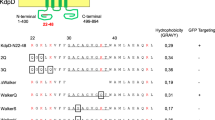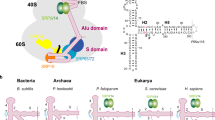Abstract
Ffh is a component of a bacterial ribonucleoprotein complex homologous to the signal recognition particle (SRP) of eukaryotes. It comprises three domains that mediate both binding to the hydrophobic signal sequence of the nascent polypeptide and the GTP-dependent interaction of Ffh with a structurally homologous GTPase of the SRP receptor. The X-ray structures of the two-domain 'NG' GTPase of Ffh in complex with Mg2+GDP and GDP have been determined at 2.0 Å resolution. The structures explain the low nucleotide affinity of Ffh and locate two regions of structural mobility at opposite sides of the nucleotide-binding site. One of these regions includes highly conserved sequence motifs that presumably contribute to the structural trigger signaling the GTP-bound state. The other includes the highly conserved interface between the N and G domains, and supports the hypothesis that the N domain regulates or signals the nucleotide occupancy of the G domain.
This is a preview of subscription content, access via your institution
Access options
Subscribe to this journal
Receive 12 print issues and online access
$189.00 per year
only $15.75 per issue
Buy this article
- Purchase on Springer Link
- Instant access to full article PDF
Prices may be subject to local taxes which are calculated during checkout





Similar content being viewed by others
References
Walter, P. & Johnson, A.E. Signal sequence recognition and protein targeting to the endoplasmic reticulum membrane. Annu. Rev. Cell Biol. 10, 87–119 (1994).
Miller, J.D., Bernstein, H.D. & Walter, P. Interaction of E. coli Ffh/4.5S ribonucleoprotein and FtsY mimics that of mammalian signal recognition particle and its receptor. Nature 367, 657–659 (1994).
Kusters, R. et al. The functioning of the SRP receptor FtsY in protein-targeting in E. coli is correlated with its ability to bind and hydrolyse GTP. FEBS Lett. 372, 253–258 (1995).
Powers, T. & Walter, P. Co-translational protein targeting catalyzed by the Escherichia coli signal recognition particle and its receptor. EMBO J. 16, 4880–4886 (1997).
Powers, T. & Walter, P. Reciprocal stimulation of GTP hydrolysis by two directly interacting GTPases. Science 269, 1422–1424 (1995).
Hauser, S., Bacher, G., Dobberstein, B. & Lütcke, H. A complex of the signal sequence binding protein and the SRP RNA promotes translocation of nascent proteins. EMBO J. 14, 5485–5493 (1995).
Rapiejko, P.J. & Gilmore, R. Signal sequence recognition and targeting of ribosomes to the endoplasmic reticulum by the signal recognition particle do not require GTP. Mol. Biol. Cell 5, 887–897 (1994).
Connolly, T. & Gillmore, R. The signal recognition particle receptor mediates the GTP-dependent displacement of SRP from the signal sequence of the nascent polypeptide. Cell 57, 599–610 (1989).
Zopf, D., Bernstein, H., Johnson, A.E. & Walter, P. The methionine-rich domain of the 54 kD protein subunit of the signal recognition particle contains an RNA binding site and can be crosslinked to a signal sequence. EMBO J. 9, 4511–4517 (1990).
Römisch, K., Webb, J., Lingelbäch, K., Gausepohl, H. & Dobberstein, B. The 54-kD protein of signal recognition particle contains a methionine-rich RNA binding domain. J. Cell Biol. 111, 1793–1802 (1990).
Lütcke, H., High, S., Römisch, K., Ashford, A.J. & Dobberstein, B. The methionine-rich domain of the 54 kDa subunit of signal recognition particle is sufficient for the interaction with signal sequences. EMBO J. 11, 1543–1551 (1992).
Jagath, J.R., Rodnina, M.V., Lentzen, G. & Wintermeyer, W. Interaction of guanine nucleotides with the signal recognition particle from Escherichia coli. Biochemistry 37, 15408–15413 (1998).
Moser, C., Mol, O., Goody, R.S. & Sinning, I. The signal recognition particle receptor of Escherichia coli (FtsY) has a nucleotide exchange factor built into the GTPase domain. Proc. Natl. Acad. Sci. USA 94, 11339–11344 (1997).
Bacher, G., Lütcke, H., Jungnickel, B., Rapoport, T.A. & Dobberstein, B. Regulation by the ribosome of the GTPase of the signal-recognition particle during protein targeting. Nature 381, 248–251 (1996).
Miller, J.D., Wilhelm, H., Gierasch, L., Gilmore, R. & Walter, P. GTP binding and hydrolysis by the signal recognition particle during initiation of protein translocation. Nature 366, 351–354 (1993).
Rapiejko, P.J. & Gilmore, R. Empty site forms of the SRP54 and SR alpha GTPases mediate targeting of ribosome-nascent chain complexes to the endoplasmic reticulum. Cell 89, 703–713 (1997).
Freymann, D.M., Keenan, R.J., Stroud, R.M. & Walter, P. Structure of the conserved GTPase domain of the signal recognition particle. Nature 385, 361–364 (1997).
Montoya, G., Svensson, C., Luirink, J. & Sinning, I. Crystal structure of the NG domain from the signal-recognition particle receptor FtsY. Nature 385, 365–369 (1997).
Zheng, N. & Gierasch, L.M. Domain interactions in E. coli SRP: stabilization of M domain by RNA is Required for effective signal sequence modulation of NG domain. Mol. Cell 1, 1–20 (1997).
Zopf, D., Bernstein, H.D. & Walter, P. GTPase domain of the 54-kD subunit of the mammalian signal recognition particle is required for protein translocation but not for signal sequence binding. J. Cell Biol. 120, 1113–1121 (1993).
Newitt, J.A. & Bernstein, H.D. The N-domain of the signal recognition particle 54-kDa subunit promotes efficient signal sequence binding. Eur. J. Biochem. 245, 720–729 (1997).
Bourne, H.R., Sanders, D.A. & McCormick, F. The GTPase superfamily: a conserved switch for diverse cell functions. Nature 348, 125–132 (1990).
Kjeldgaard, M., Nyborg, J. & Clark, B.F.C. The GTP binding motif: variations on a theme. FASEB J. 10, 1347–1368 (1996).
Sprang, S.R. G Protein mechanisms: insights from structural analysis. Annu. Rev. Biochem. 66, 639–678 (1997).
Kjeldgaard, M. & Nyborg, J. Refined structure of elongation factor Tu from Escherichia coli. J. Mol. Biol. 223, 721–742 (1992).
Tong, L.A., de Vos, A.M., Milburn, M.V. & Kim, S.H. Crystal structures at 2.2 Å resolution of the catalytic domains of normal ras protein and an oncogenic mutant complexed with GDP. J. Mol. Biol. 217, 503–516 (1991).
Scheffzek, K., Klebe, C., Fritz-Wolf, K., Kabsch, W. & Wittinghofer, A. Crystal structure of the nuclear Ras-related protein Ran in its GDP-bound form. Nature 374, 378–381 (1995).
Al-Karadaghi, S., Ævarsson, A., Garber, M., Zheltonosova, J. & Liljas, A. The structure of the elongation factor G in complex with GDP: conformational flexibility and nucleotide exchange. Structure 4, 555–565 (1996).
Czworkowski, J., Wang, J., Steitz, T.A. & Moore, P.B. The crystal structure of elongation factor G complexed with GDP, at 2.7 Å resolution. EMBO J. 13, 3661–3668 (1994).
Mixon, M.B. et al. Tertiary and quaternary structural changes in Giα1 induced by GTP hydrolysis. Science 270, 954–960 (1995).
Keenan, R.J., Freymann, D.M., Walter, P. & Stroud, R.M. Crystal structure of the signal sequence binding subunit of the signal recognition particle. Cell 94, 181–191 (1998).
Berghuis, A.M., Lee, E., Raw, A.S., Gilman, A.G. & Sprang, S.R. Structure of the GDP-Pi complex of Gly203→Ala Gialpha1: a mimic of the ternary product complex of Galpha-catalyzed GTP hydrolysis. Structure 4, 1277–1290 (1996).
Farmery, M., Macao, B., Larsson, T. & Samuelsson, T. Binding of GTP and GDP induces a significant conformational change in the GTPase domain of Ffh, a bacterial homologue of the SRP 54 kDa subunit. Biochim. Biophys. Acta 1385, 61–68 (1998).
Bohm, A., Gaudet, R. & Sigler, P.B. Structural aspects of heterotrimeric G-protein signaling. Curr. Opin. Biotechnol. 8, 480–487 (1997).
Onrust, R. et al. Receptor and betagamma binding sites in the alpha subunit of the retinal G protein transducin. Science 275, 381–384 (1997).
Teng, T.-Y. Mounting of crystals for macromolecular crystallography in a free-standing thin film. J. Appl. Crystallogr. 23, 387–391 (1990).
Otwinowski, Z. Oscillation data reduction program. In Data collection and processing (eds Sawyer, L., Isaacs, N.W. & Bailey, S.) 55–62 (SERC Daresbury Laboratory, Warrington, United Kingdom; 1993).
Navaza, J. AMoRe: an automated package for molecular replacement. Acta Crystallogr. A 50, 157–163 (1994).
Brünger, A.T. X-PLOR: a system for X-ray crystallography and NMR. (Yale University Press, New Haven, Connecticut; 1992).
Jones, T.A., Zou, J.Y., Cowan, S.W. & Kjeldgaard, M. Improved methods for building protein models in electron density maps and the location of errors in these models. Acta Crystallogr. A 47, 110–119 (1991).
Jiang, J.-S. & Brünger, A.T. Protein hydration observed by X-ray diffraction. J. Mol. Biol. 243, 100–115 (1994).
Laskowski, R.A., MacArthur, M.W., Moss, D.S. & Thornton, J.M. PROCHECK: a program to check the stereochemical quality of protein structures. J. Appl. Crystallogr. 26, 283–291 (1993).
Glusker, J.P. Structural aspects of metal liganding to functional groups of proteins. Adv. Protein Chem. 42, 1–76 (1991).
Kleywegt, G.J. & Jones, T.A. Detecting folding motifs and similarities in protein structures. Methods Enzymol. 277, 525–545 (1997).
Evans, S.V. SETOR: hardware-lighted three-dimensional solid model representations of macromolecules. J. Mol. Graph. 11, 134–138 (1993).
Ihara, K. et al. Crystal structure of human RhoA in a dominantly active form complexed with a GTP analogue. J. Biol. Chem. 273, 9656–9666 (1998).
Hirshberg, M., Stockley, R.W., Dodson, G. & Webb, M.R. The crystal structure of human rac1, a member of the Rho family complexed with a GTP analogue. Nature Struct. Biol. 4, 147–151 (1997).
Diederichs, K. & Karplus, P.A. Improved R-factors for diffraction data analysis in macromolecular crystallography. Nature Struct. Biol. 4, 269–275 (1997).
Acknowledgements
We thank J. Richardson of Duke University for an illuminating discussion. This work was begun while D.M.F. was a postdoctoral fellow in the laboratories of P.W. and R.M.S. It was supported by grants to P.W. and R.M.S. from the NIH and by the Herb Boyer Fund and the Biotechnology Program of the University of California. It is based in part on research conducted at the Stanford Synchrotron Radiation Laboratory (SSRL), a facility funded by the Department of Energy, Office of Basic Energy Sciences. P.W. is an investigator in the Howard Hughes Medical Institute.
Author information
Authors and Affiliations
Corresponding author
Rights and permissions
About this article
Cite this article
Freymann, D., Keenan, R., Stroud, R. et al. Functional changes in the structure of the SRP GTPase on binding GDP and Mg2+GDP. Nat Struct Mol Biol 6, 793–801 (1999). https://doi.org/10.1038/11572
Received:
Accepted:
Issue Date:
DOI: https://doi.org/10.1038/11572
This article is cited by
-
Molecular basis and current insights of atypical Rho small GTPase in cancer
Molecular Biology Reports (2024)
-
Inhibition of SRP-dependent protein secretion by the bacterial alarmone (p)ppGpp
Nature Communications (2022)
-
GTPase twins in the SRP family
Nature Structural & Molecular Biology (2004)
-
SRP meets the ribosome
Nature Structural & Molecular Biology (2004)



